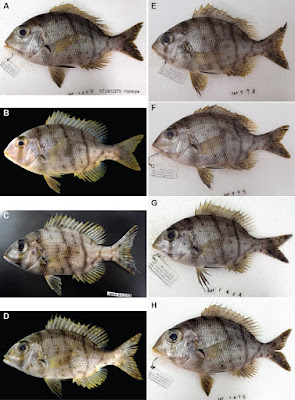 |
| Gymnocranius obesus
Chen, Miki & Borsa, 2017
|
Abstract
Two previously recorded new species of the large-eye seabream genus Gymnocranius (Gymnocranius sp. D and Gymnocranius sp. E) remain undescribed. Here we describe Gymnocranius sp. E as Gymnocranius obesus sp. nov. This new species is morphologically distinct from all other known species under Gymnocranius by the following combination of characters: relatively deep body, with ratio of standard length to body depth 2.2–2.4; protruding large eye, with eye diameter about equal to or slightly larger than inter-orbital width; caudal fin moderately forked; no blue spots or wavy blue lines on cheek and snout in adults; fourth transversal dark bar on flank running from the sixth spine of the dorsal fin to the origin of the anal fin; anal, caudal and dorsal fins drab with yellowish to yellow margins. Gymnocranius obesus sp. nov. is distinct from G. griseus, with which it has been previously confused by a relatively larger head, scales above lateral line without dark basal patch, and a smaller number of front scales on the dorsal side of the head. Gymnocranius obesus sp. nov. is genetically distinct from its closest known relative, Gymnocranius sp. D by 104 diagnostic nucleotide characters, which translates into a 9.6% sequence divergence at the mitochondrial cytochrome b gene. Gymnocranius obesus sp. nov. reaches a length of at least 295 mm. Its distribution, from the Ryukyu Islands to Bali, including Taiwan and the Flores Sea, mostly coincides with the western half of the Coral Triangle.
Keywords: New species, Indo-West Pacific, Gymnocranius sp. D, Gymnocranius griseus
Gymnocranius obesus sp. nov.
Previously referred to as Gymnocranius sp. E [Borsa, et al., 2013],
Gymnocranius sp. 1 [Anonymous, 2016],
Gymnocranius griseus [Chiang, et al., 2014],
and Gymnocranius grandoculis [Shao, 2016].
Diagnosis: Gymnocranius obesus sp. nov. differs from its morphologically close congeners G. griseus and Gymnocranius sp. D by the number of front scales on the top of the head, and by the dark-bar patterns on flanks. While the fourth transversal dark bar in G. obesus sp. nov. runs from the basis of the sixth spine of the dorsal fin down to the origin of the anal fin, the one in G. griseus, when visible, runs down from the base of the sixth dorsal spine to the abdomen (Table 3). That in Gymnocranius sp. D descends from the sixth dorsal spine to the extremity of abdomen, before the anus (Table 3).
Along the cytochrome b gene, the following apomorphic sites have nucleotides shared by all five specimens of G. obesus sp. nov. examined so far, that are not present in G. elongatus, G. euanus, G. grandoculis, G. griseus, G. oblongus, G. satoi, G. superciliosus and Gymnocranius sp. D: Nos. 61, 108, 117, 135, 153, 165, 300, 303, 318, 375, 501, 564, 627, 630, 684, 756, 765, 816, 967, 972, and 1032. These nucleotide sites can be used for the diagnosis of G. obesus sp. nov. relative to G. griseus and Gymnocranius sp. D.
Etymology: Epithet obesus is the Latin translation of obese, a reference to the deep and relatively thick body shape of the specimens of this species. We propose the Obese Large-eye Seabream as vernacular name for G. obesus sp. nov.
Wei-Jen Chen, Ryohei Miki and Philippe Borsa. 2017. Gymnocranius obesus, A New Large-eye Seabream from the Coral Triangle. Comptes Rendus Biologies. In Press. DOI: 10.1016/j.crvi.2017.08.004
2017. Gymnocranius obesus, un nouveau bossu blanc du Triangle de Corail.
Résumé: Deux nouveaux bossus blancs du genre Gymnocranius, précédemment signalés comme Gymnocranius sp. D et Gymnocranius sp. E, restent non décrits. Nous décrivons ici Gymnocranius sp. E comme Gymnocranius obesus sp. nov. Cette nouvelle espèce est morphologiquement distincte de toutes les autres espèces connues du genre Gymnocranius par la combinaison de caractères suivante : corps relativement haut, où le rapport de la longueur standard à la hauteur du corps est 2,2–2,4 ; œil saillant, large, dont le diamètre est approximativement égal ou légèrement supérieur à la distance interorbitaire ; nageoire caudale modérément fourchue ; pas de taches bleues ni de lignes bleues ondulées sur la joue et le museau chez les adultes ; quatrième barre transversale sombre sur le flanc allant de la base du sixième rayon de la nageoire dorsale à l’origine de la nageoire anale ; bord externe des nageoires anale, caudale et dorsale jaunâtre à jaune. Gymnocranius obesus sp. nov. se distingue de G. griseus, avec lequel il a été précédemment confondu, par une tête relativement plus grande, des écailles au-dessus de la ligne latérale sans patch basal sombre, et un plus petit nombre d’écailles frontales sur le dos de la tête. Gymnocranius obesus sp. nov. est génétiquement distinct de son plus proche parent connu, Gymnocranius sp. D, par 104 caractères nucléotidiques diagnostiques au gène mitochondrial du cytochrome b, ce qui se traduit par une divergence de séquence de 9,6 %. Gymnocranius obesus sp. nov. atteint au moins 295 mm de longueur. Sa distribution, des îles Ryukyu à Bali en passant par Taïwan et la mer de Flores, coïncide essentiellement avec la moitié ouest du Triangle de Corail.
Mots clés: Nouvelle espèce, Indo-Pacifique ouest, Gymnocranius sp. D, Gymnocranius griseus





